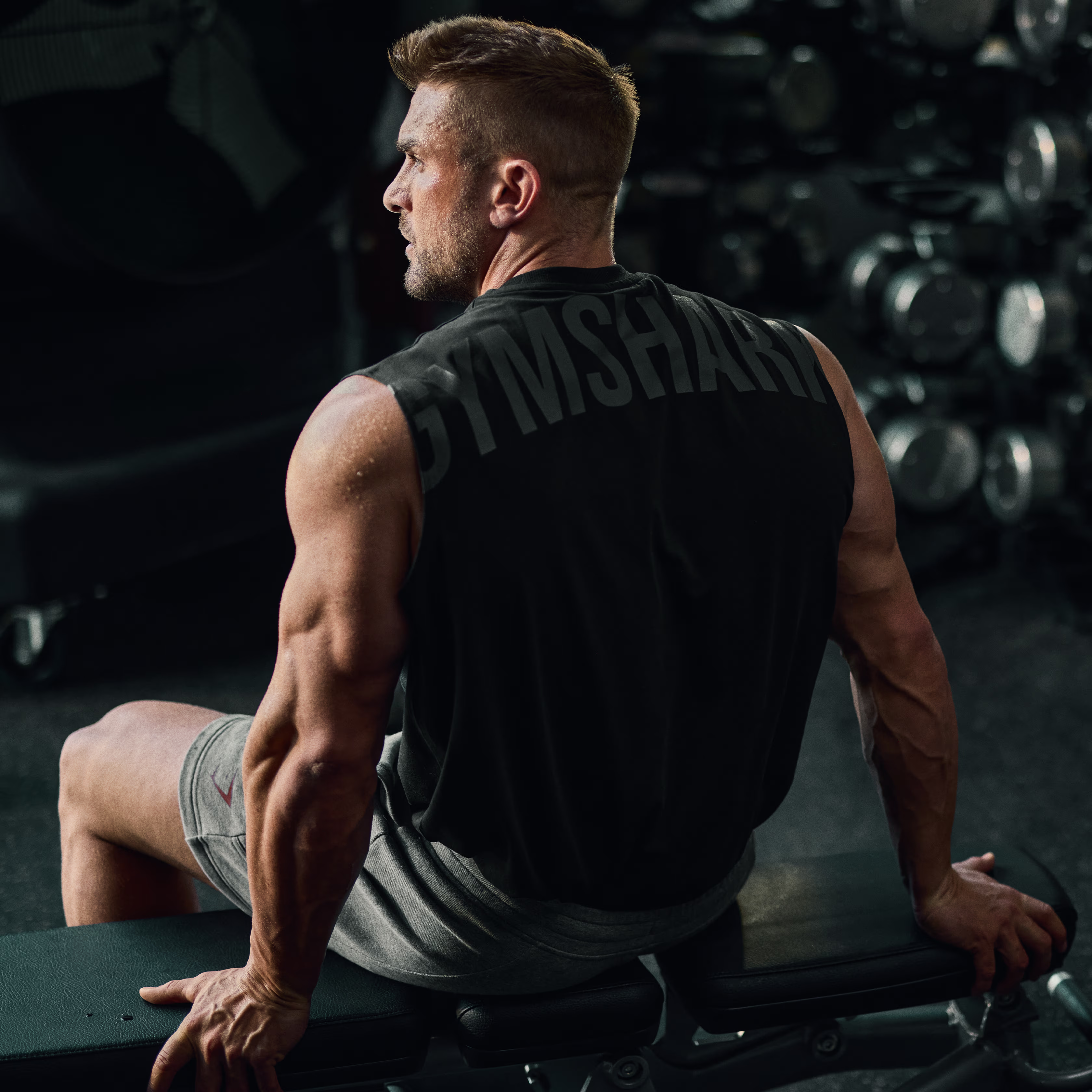Supersets, a tool to find the balance between volume and efficiency
Author:
Julio Valero
Published on:
12/4/2024

The effect of different rest intervals between paired agonist and antagonist bouts on training performance and efficiency.
Supersets are known to save time, but how much rest should you give between them to maintain an effective workout?
Overview
What was the experimental design? The study compared the effect of fixed and variable rest intervals on training performance and economy, measuring variables such as total volume and session duration.
What was the finding? Shorter breaks are associated with lower volume and shorter sessions, while longer breaks imply higher volume and longer sessions.
What does it mean for you to rest between sets based on your own needs? This strategy could shorten your workouts without sacrificing volume.
What is the problem?
Supersets, a high-intensity training technique, are highly appreciated by those looking to maximize results in less time. By performing two exercises consecutively, the muscular demand is increased and recovery is accelerated.
Complex training is a technique that involves performing two or more exercises consecutively, without rest in between. These exercises share similar movement patterns, allowing for increased strength and power by preloading muscles with heavy loads before performing explosive movements.
Compound sets are characterized by the sequential execution of exercises that involve the same muscle group. In contrast, agonist-antagonist paired sets (APS) pair exercises that activate muscles with opposite actions. For example, during a biceps curl, the biceps contracts concentrically (agonist muscle), while the triceps is stretched (antagonist muscle). By alternating these exercises, the principle of active recovery is taken advantage of, where one muscle rests while the other works, thus optimizing training time and promoting greater muscle fatigue.

Rest intervals (RI) are a critical factor in training program design. Inappropriate rest periods can undermine both training volume and intensity. Excessively long RIs unnecessarily extend training sessions, while excessively short RIs hinder recovery between sets, limiting subsequent intensity and volume. APS offers a potential solution by optimizing the balance between efficiency and recovery. This can be achieved by streamlining training sessions while ensuring adequate recovery to support both intensity and volume. Training efficiency can be evaluated by considering session time and total training volume (TTV). To enhance efficiency, one can either reduce session time while maintaining TTV or increase TTV while keeping session time constant.
Previous research suggests that incorporating the APS method does not hinder, and may even enhance, TTV compared to traditional set training. Prior studies comparing rest intervals within APS have demonstrated that shorter rest periods (one minute or less) can increase training volume. However, optimal rest intervals between superset sequences for maximizing training efficiency and volume remain relatively unexplored. This study is unique in its examination of self-selected rest intervals (SRI) between APS, investigating their potential impact on training efficiency and TTV. For clarity, we will consistently use the term "superset" throughout this article to refer to APS.
Purpose
This study compared fixed (1, 2, and 3 minute) and self-selected rest intervals (SRI) to determine their impact on training volume and efficiency in superset workouts.
Hypothesis
Researchers anticipated that a self-selected rest interval strategy would optimize training efficiency to a greater extent than a fixed interval strategy.

What Were the Test Subjects and Methodology?
Participants
Eighteen male Brazilian army soldiers with approximately one year of training, averaging three training sessions per week, participated in the study.
Study Procedures
A randomized crossover design was employed in this study. Each participant was subjected to both experimental protocols, with a 48-hour interval between them.
The horizontal bench press (BP), lying bench row (BR), seated lat pull-down (LP), and the overhead press The horizontal bench press (BP), lying bench row (BR), seated lat pull-down (LP), and the overhead press (OP) were performed in each protocol. The 10 repetition maximum (10RM) testing was performed with a maximum of three attempts for each exercise, with a five minute RI between each attempt and a ten minute RI between exercises. Following a standardized warm-up, the first superset BP + BR was performed with a 10-second transition between exercises, and then the randomized RI protocol (1RI, 2RI, 3RI or SRI) was performed between each completed superset. The sequence was repeated for three total sets, then the second superset LP + OP was performed following the same procedures. All exercises were performed with standardized repetitions until incorrect form was used or if failure was achieved. The SRI duration was as long as the participant needed to perform the next paired set at the required intensity and RI was timed by the examiner.
Measurements
For each training session and exercise, the total number of repetitions performed and the total training volume (TTV) were calculated using the formula: TTV = Reps x Sets x Weight.
Training Session Time: Quantified by the examining official.
Efficiency was measured by the proportion of session time dedicated to TTV.
What Did They Find?
Total Number of Repetitions and TTV
Longer rest intervals produced more total reps and higher TTV. The 1RI protocol resulted in significantly lower training volume compared to the other conditions (p = 0.000); the 3RI protocol demonstrated significantly higher training volume than the 1RI (p = 0.000) and 2RI (p = 0.002) protocols, but not significantly different from the SRI protocol, as shown in Table 1 below. Additionally, there was no significant differences between the 2RI and SRI for total number of reps and TTV.
Total number of completed repetitions and total training volume (TTV)
Measurement | 1RI | 2RI | 3RI | SRI |
Total Repetitions | 78.5 ± 13.3 | 92.3 ± 16.0* | 101.9 ± 14.6*# | 96.8 ± 15.9* |
TTV (kg) | 4,395 ± 886 | 5,196 ± 1,061* | 5,732 ± 1,009*# | 5,433 ± 1,048* |
The values are mean ± SD*
** = Significant difference for 1RI (p < 0.05)* =(p < 0.05)*
# = Significant difference for 2RI (p < 0.05)
Training Volume per Superset and Per Exercise
It is unsurprising that all rest interval durations resulted in a significant decrease in training volume between sets during the BR + BP superset (Figure 2). In contrast, the SRI protocol was the only one to maintain significant volume consistency between sets (1-2, p = 0.358; 2-3, p = 1.000) for the LP + OP superset. As anticipated, the OP consistently demonstrated a significant reduction in training volume compared to other exercises (BR and BP, p = 0.000; 1RI, 2RI, and SRI LP, p = 0.000; 3RI LP, p = 0.001) across all rest intervals. Furthermore, only the 1RI protocol induced a significant reduction in LP training volume relative to BR (p = 0.020).
Training Session Effectiveness
The 3RI protocol required significantly longer training sessions than the 1RI and 2RI protocols (p < 0.01), while the 1RI protocol had significantly shorter training sessions than the other rest intervals (p < 0.001), as shown in Table 2.
The 1RI protocol yielded significantly higher training efficiency compared to the 3RI and SRI protocols (p < 0.001) and the 2RI protocol (p < 0.01). The 2RI protocol resulted in significantly higher efficiency than the 3RI protocol (p < 0.01). No significant differences were observed in training session time or efficiency between the 2RI and SRI protocols.
The SRI protocol involved an average rest period of 146 ± 48 seconds (~2.5 minutes) between sets. The average SRI between sets 2 and 3 of the BR + BP superset was 179 ± 57 seconds, significantly longer than the first (p < 0.012), third (p < 0.038), and fourth (p < 0.001) rest intervals.
Training session time and efficiency
Measurement | 1RI | 2RI | 3RI | SRI |
Total Repetitions | 78.5 ± 13.3 | 92.3 ± 16.0* | 101.9 ± 14.6*# | 96.8 ± 15.9* |
TTV (kg) | 4,395 ± 886 | 5,196 ± 1,061* | 5,732 ± 1,009*# | 5,433 ± 1,048* |
The values are mean ± SD
** = Significant difference for 1RI (p < 0.05)*
# = Significant difference for 2RI (p < 0.05)
What Do the Findings Mean?
Our analysis reveals an interesting trade-off between rest interval duration and training outcomes. While a 1-minute rest interval (1RI) maximizes training efficiency (weight lifted per unit time), it compromises total training volume (TTV). Conversely, a 3-minute rest interval (3RI) allows for greater TTV but sacrifices efficiency.
The 2-minute rest interval (2RI) and the shorter-than-two-minute rest interval (SRI) seem to offer a reasonable compromise. Both provide substantial TTV without excessively long training sessions. While the SRI might marginally edge out the 2RI in terms of time efficiency, the difference isn't statistically significant.
Ultimately, the optimal rest interval depends on your specific goals. If time efficiency is paramount, a shorter rest interval might be preferable. However, if maximizing muscle growth is the primary objective, a longer rest interval may be more beneficial. Most individuals will find a balance between the two, with a 2-minute rest interval often providing a good starting point.
Another study found no significant difference in the number of repetitions performed between a 2-rep-in-reserve (2RI) and a single-rep-in-reserve (SRI) set, with an average rest time of approximately 157 seconds for both.
Given that the average rest time for the SRI condition in the current study was 2.5 minutes, it appears that a rest period between 2 and 2.5 minutes may be optimal for maximizing training efficiency without sacrificing volume.
However, the current study also revealed no significant differences in training volume between 3RI and SRI sets, with the SRI condition leading to significantly shorter session durations. Furthermore, the SRI was the only interval that prevented a significant reduction in training volume for the second superset (LP + OP).
Based on these findings, the SRI may be the most effective approach for maximizing both training volume and efficiency.

We briefly noted in the findings section that training volume for overhead press significantly decreased compared to other exercises. This occurred in the second superset sequence (leg press + overhead press), where the overhead press followed the leg press and three sets of bench press. This suggests that fatigue accumulation likely contributed to the reduced volume. However, we cannot rule out the possibility that this superset pairing (leg press + overhead press) is suboptimal. Previous research indicates that pairing agonist-antagonist muscle groups, like leg extensions and leg curls, can enhance performance due to neural preactivation effects. This suggests that a different superset pairing might have yielded better results for the overhead press. So, maybe the combination of LP + OP results in less preactivation of the shoulder muscles after performing lat pulldowns, therefore inhibiting greater contractions. While this hypothesis remains speculative and cannot be definitively confirmed by our study, it would be worthwhile to conduct further research exploring various muscle group supersets to assess their impact on exercise performance and muscle activation.
How Can You Apply These Findings?
This study reinforces the potential benefits of a self-selected rest interval approach, where individuals rest until they feel prepared for the next set. While this method offers flexibility, it's crucial to balance rest duration to avoid excessive downtime or loss of focus.
A practical strategy is to set a timer for approximately 2.5 minutes. This timeframe allows for adequate recovery without disrupting the training flow. For those prioritizing time efficiency or aiming to maximize training volume within a limited timeframe, a 2-minute timer can be effective. Conversely, individuals seeking to prioritize volume per session may benefit from a fixed 3-minute rest interval.
Given the nature of supersets, they are generally more suitable for higher-rep range exercises and volume-based training. In strength-focused programs, supersets may be appropriate for accessory movements or higher-rep volume work towards the end of a session. However, they are typically not ideal for high-intensity, low-rep core lifts like bench press or squats.
References
Behenck, C., SantʼAna, H., Pinto de Castro, J. B., Willardson, J. M., & Miranda, H. (2020). The Effect of Different Rest Intervals Between Agonist-Antagonist Paired Sets on Training Performance and Efficiency. Journal of Strength and Conditioning Research.
Robbins, D. W., Young, W. B., Behm, D. G., & Payne, W. R. (2010). Agonist-antagonist paired set resistance training: a brief review. Journal of strength and conditioning research, 24(10), 2873–2882.
Robbins, D. W., Young, W. B., Behm, D. G., & Payne, W. R. (2010). The effect of a complex agonist and antagonist resistance training protocol on volume load, power output, electromyographic responses, and efficiency. Journal of strength and conditioning research, 24(7), 1782–1789.
Robbins, D. W., Young, W. B., & Behm, D. G. (2010). The effect of an upper-body agonist-antagonist resistance training protocol on volume load and efficiency. Journal of strength and conditioning research, 24(10), 2632–2640.
Paz, G. A., Robbins, D. W., de Oliveira, C. G., Bottaro, M., & Miranda, H. (2017). Volume Load and Neuromuscular Fatigue During an Acute Bout of Agonist-Antagonist Paired-Set vs. Traditional-Set Training. Journal of strength and conditioning research, 31(10), 2777–2784.
Zhao, H., Yamaguchi, S., & Okada, J. (2020). Effects of rest interval array on training volume, perceived exertion, neuromuscular fatigue, and metabolic responses during agonist-antagonist muscle alternative training. The Journal of sports medicine and physical fitness, 60(4), 536–543.
Maia, M. F., Willardson, J. M., Paz, G. A., & Miranda, H. (2014). Effects of different rest intervals between antagonist paired sets on repetition performance and muscle activation. Journal of strength and conditioning research, 28(9), 2529–2535.
De Salles, B. F., Polito, M. D., Goessler, K. F., Mannarino, P., Matta, T. T., & Simão, R. (2016). Effects of fixed vs. self-suggested rest between sets in upper and lower body exercises performance. European journal of sport science, 16(8), 927–931.
Goessler, K., & Polito, M. (2013). Effect of fixed and self-suggested rest intervals between sets of resistance exercise on post-exercise cardiovascular behavior. Brazilian Journal of Kinanthropometry and Human Performance, 15(4), 467-475.
Roy, MA, Sylvestre, M, Katch, FI, and Lagasse, PP. Proprioceptive facilitation of muscle tension during unilateral and bilateral knee extension. Int J Sports Med 11: 289–292, 1990.
Comparte en redes sociales
Recent posts

A bad night's sleep: a reason to stay up even longer?

Creatine Effectiveness: What Does Science Say About Its Benefits?

Does meal timing help you lose fat?

Is your triceps press building muscle or holding you back?

Nutrition tailored to you: based on your genetic profile.

Carbohydrates: the key to an explosive workout.